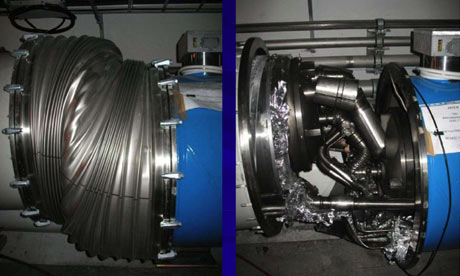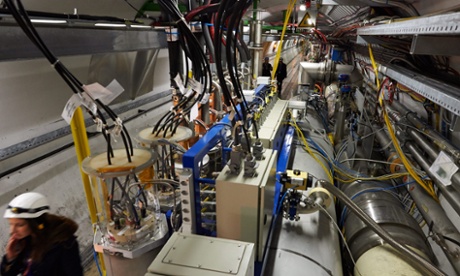It's been nearly a year since the world's biggest science experiment, the Large Hadron Collider (LHC), was fired up for the first time in a flurry of excitement at Cern, the European Centre for Nuclear Research in Switzerland. But ever since a catastrophic explosion in the particle accelerator's tunnel just nine days after startup, the gargantuan machine has sat idling, to the acute frustration and no little embarrassment of all involved.
The incident on 19 September, variously described as an "electrical failure", "engineering breakdown" and "technical malfunction", was a major setback to physicists hoping to discover the Higgs boson (or "champagne bottle boson", as we rechristened it). It was caused when a short-circuit in a connection between superconductors in the tunnel burned a hole in a vessel containing liquid helium – resulting in an explosion.
Engineers have been working hard to get the $9bn supermachine up and running. They have now finished testing the 10,000 high-current, superconducting connections and repairing those in which the resistance was found to be abnormally high.
They've also installed highly sensitive warning systems in an attempt to avoid a repeat of the liquid helium leak.
There's more work to be done, though, including calibrating the detectors, installing 160km of new cabling around the tunnel, and cooling down the sectors that had to be warmed up to allow repairs (when it's colliding particles, the accelerator tunnel is cooled close to absolute zero).
All in all, the atom smasher's refit will rack up a bill in the region of 40m Swiss francs (£23m).
Last week, Cern announced that the LHC will finally begin firing protons around its 27km circular tunnel again in November. Initially, it will run at an energy of 3.5 tera-electronvolts (TeV) per beam – just half of what it's meant to achieve at full blast, but still several times more than the LHC's American competitor, the Tevatron at Fermilab, can manage. After operating at this lower level for a period, the energy will be increased to 5TeV per beam.
According to Cern spokesman James Gillies, the mood at Cern is optimistic.
"We're looking forward to getting going," he said. "There's consensus that the choices that have been taken to run the machine safely at 3.5TeV per beam are good choices. They allow the machine operators to learn how to drive the machine, if you like, under what should be very easy conditions for them, and they don't compromise the physics."
Gillies is confident that there won't be another serious mishap this time around.
"There will be small things, and that's part of life, but I don't think we're going to see another major setback like the one we had last year."
Once a good amount of data has been collected at lower energy levels, the LHC will have to be shut down again while it is geared up to reach 7TeV per beam. This will require dozens of superconducting magnets to be "retrained" – conditioned by gradual exposure to higher and higher currents.
The energy of a collision between two particles in the tunnel is converted into the mass of any new particles that are created, in keeping with Einsteins's celebrated equation E=mc2. The more energetic the collision, the more massive the particles that might be created, as physicist Adam Yurkewicz explains on the LHC's US blog.
"For example, to discover a dark matter particle, the energy of the collision is converted into the mass of the new particle. Right now, we don't know exactly what mass the dark matter particle has, so the higher the collision energy, the more massive particle we could potentially make. Our potential to discover something new depends on the energy of the collisions."
For this reason, physicists are eager to get the collider running at full energy as soon as possible. But according to Peter Kalmus, emeritus professor of physics at Queen Mary, University of London, there are other considerations.
"We're looking for something that is almost bound to be rare," he said. "One has to have a very well understood apparatus, not just the accelerator but also the detectors that would be looking for it. It seems to me that people probably need, I would think, certainly much more than a year of operating the machine just to make sure that they understand all the nitty-gritty of quirks in the equipment."
Kalmus believes Cern are still the favourites to get their hands on the elusive Higgs before their American rivals.
"I think Cern ought to have the edge, but there is still a chance that Fermilab could come up with it," he said.
The Higgs boson would certainly be the prize in any hunt, but it is by no means the only target in the LHC's sights. Physicists also hope to verify the existence of supersymmetry – the idea that the known particles have heavier partners that have yet to be discovered.
"If they exist, and if the masses are not very much higher, then they could be discovered with the lower energy machine," says Kalmus.
There will be an anxious wait for the physics community between now and November. For researchers desperate to get their hands on some data, the resurrection of the LHC can't come a minute too soon.
"Collisions this year will bring joy, but first probably relief," Yurkewicz writes. "Relief at not having to answer questions about the LHC not working, and relief for graduate students who would have data they could analyse in order to graduate.
"Many of us will be holding our breath for the next few months. After we see some collisions we can experience that joy, and then start down the long path towards answering some of the fundamental questions we have about the universe."









